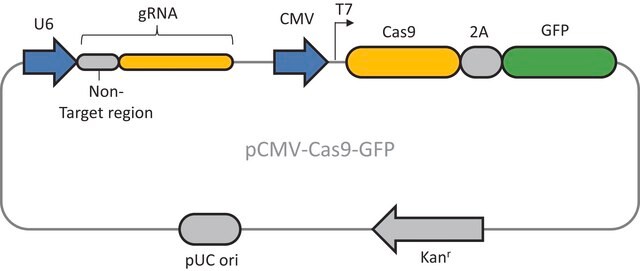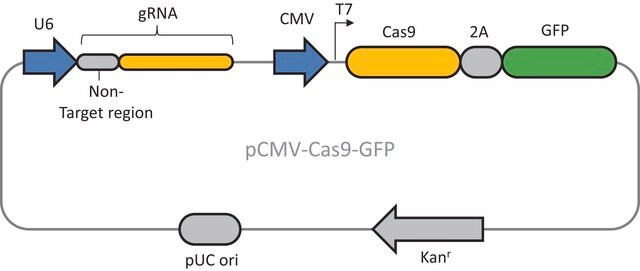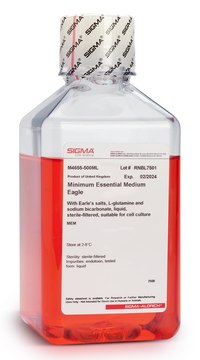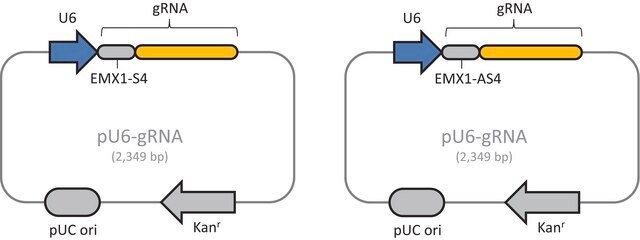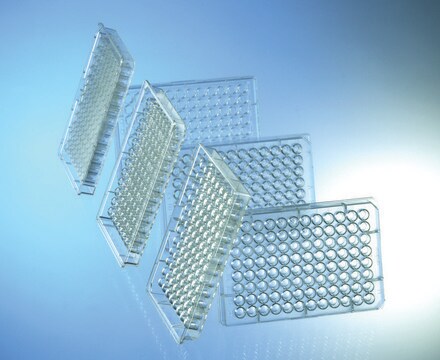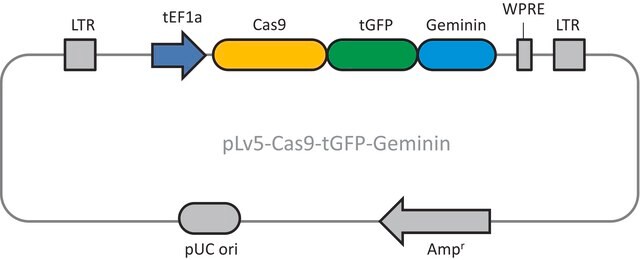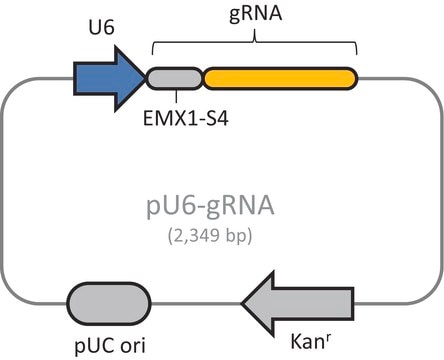Recommended Products
form
liquid
Quality Level
packaging
vial of 50 μL
concentration
20 ng/μL in TE buffer; DNA (1μg of plasmid DNA)
application(s)
CRISPR
shipped in
dry ice
storage temp.
−20°C
Related Categories
General description
Universal negative control CRISPRs have been designed not to recognize any sequence in the human, mouse or rat genome. A single vector format is provided which includes the Cas9 expression cassette and gRNA sequence. This vector includes GFP which is co-expressed from the same mRNA as the Cas9 protein via a 2A peptide linkage and enables for tracking of transfection efficiency or enrichment in cell populations via FACS.
Application
Functional Genomics/Target Validation
- Creation of gene knockouts in cell lines
- Creation of knock-in cell lines with promoters, fusion tags or reporters integrated into endogenous genes
Features and Benefits
Allows for expression of Cas9 and GFP without specific targeting of the CRISPR/Cas9 system.
Components
1 vial containing 1ug of U6-gRNA/CMV-Cas9-GFP plasmid expressing a non-targeting guide sequence.
Principle
CRISPR/Cas systems are employed by bacteria and archaea as a defense against invading viruses and plasmids. Recently, the type II CRISPR/Cas system from the bacterium Streptococcus pyogenes has been engineered to function in eukaryotic systems using two molecular components: a single Cas9 protein and a non-coding guide RNA (gRNA). The Cas9 endonuclease can be programmed with a single gRNA, directing a DNA double-strand break (DSB) at a desired genomic location. Similar to DSBs induced by zinc finger nucleases (ZFNs), the cell then activates endogenous DNA repair processes, either non-homologous end joining (NHEJ) or homology-directed repair (HDR), to heal the targeted DSB.
Physical form
Sigma U6-gRNA/CMV-Cas9-GFP plasmid expressing a non-targeting guide sequence supplied at a concentration of 20ng/ul in 50ul.
Preparation Note
Sigma CRISPR plasmid products are delivered as mini-prep aliquots,
which may not be suitable for transfection into particular cell types. For best results, we advise maxi-prepping
plasmids using endotoxin-free DNA purification kits prior to transfection.
which may not be suitable for transfection into particular cell types. For best results, we advise maxi-prepping
plasmids using endotoxin-free DNA purification kits prior to transfection.
Other Notes
Typical transfection concentrations used in literature are in the ranges of 2.0 to 8.0ug of the single vector expressing the guideRNA and Cas9 . (All dosages above assume 0.5 to 1 million cells nucleofected)
Legal Information
Storage Class Code
12 - Non Combustible Liquids
WGK
WGK 1
Flash Point(F)
Not applicable
Flash Point(C)
Not applicable
Certificates of Analysis (COA)
Search for Certificates of Analysis (COA) by entering the products Lot/Batch Number. Lot and Batch Numbers can be found on a product’s label following the words ‘Lot’ or ‘Batch’.
Already Own This Product?
Find documentation for the products that you have recently purchased in the Document Library.
Articles
CRISPR endonucleases have shown wide variation in their activity, even among multiple CRISPRs designed within close genomic proximity.
Our team of scientists has experience in all areas of research including Life Science, Material Science, Chemical Synthesis, Chromatography, Analytical and many others.
Contact Technical Service